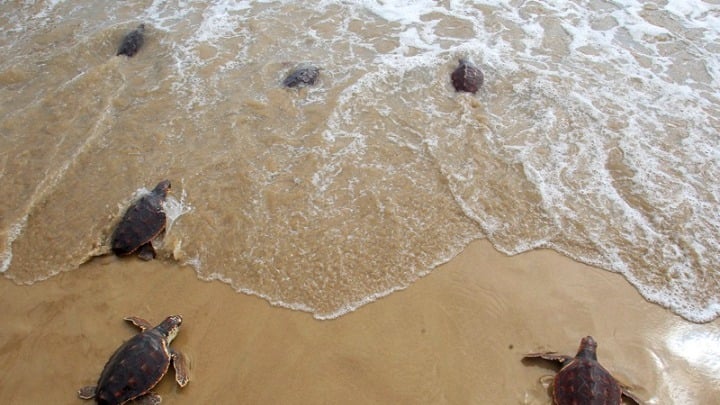
Despite the impressive egg-laying results, the Archelon report cautioned that human intervention and pressure have continued. Credit: AMNA
The loggerhead sea turtle (Caretta caretta) population in Greece is exhibiting remarkable vitality, with the Gulf of Kyparissia in the western Peloponnese maintaining its status as the species’ most vital nesting ground nationwide.
According to the 2025 annual report by the Archelon Sea Turtle Protection Society of Greece, the region experienced one of the most productive seasons in recent decades.
The report registered nearly 6,100 nests in the Gulf of Kyparissia in 2025, marking a significant 74 percent increase compared to the average of the last twelve years. This underscores the critical role Greece plays in the conservation of the sea turtle, with the Gulf of Kyparissia and the Laganas Gulf of Zakynthos combined accounting for over 57 percent of all loggerhead sea turtle nests in the entire European Union.
Archelon attributes this achievement to its systematic protection of nests and hatchlings since 1992. However, the organization stresses that this fragile achievement “necessitates the immediate institutional support of the Nature Conservation Area and the implementation of the National Action Plan for Caretta sea turtles, in order to safeguard this fragile achievement.”
Key findings for sea turtles in Greece
The latest conservation season revealed several noteworthy developments in sea turtle nesting, research, and public engagement across Greece, among these:
Nesting concentration: Of the nearly 6,100 nests recorded in Kyparissia, the majority (5,200) were concentrated within a highly protected 6 miles (9.5 km) stretch, with 900 nests found north of Neda.
Volunteers and research: The protection program, which ran from May to September, involved 90 volunteers and researchers from Greece and abroad. This team included 11 supervisory field roles and 27 college students fulfilling field report requirements.
Public outreach: The program engaged 5,800 visitors and residents through informational and educational events, including guided walks, tours of the Agiannaki Environmental Station, school presentations, voluntary beach cleanings, and briefings at seasonal stations.
Scientific research: As part of the European Project LIFE MareNatura, new satellite transmitters were placed on two adult sea turtles, yielding critical data on their feeding grounds and migratory routes.
Funding and management gaps remain
Despite the impressive egg-laying results, the Archelon report cautioned that human intervention and pressure have persisted. The organization made several urgent calls to the Greek state:
The state must accelerate the application of the National Action Plan adopted in 2021 and apply the Plan for the Management of the Natural Conservation Area.
Archelon requested immediate financial support to continue the vital work of registering and protecting nests and hatchlings. Currently, the organization states that all its actions are funded from its own resources, noting a distinct absence of funding or management actions from regional authorities.
In a positive sign for the future, the organization welcomed the planned establishment of the Marine Park of the Ionian Sea, which is expected to boost protection efforts across the region. The continued success of the Caretta caretta nesting population ultimately hinges on turning conservation policy into funded, on-the-ground action.
Related: Greece Lagging in Marine Environmental Protection, New Report Reveals
